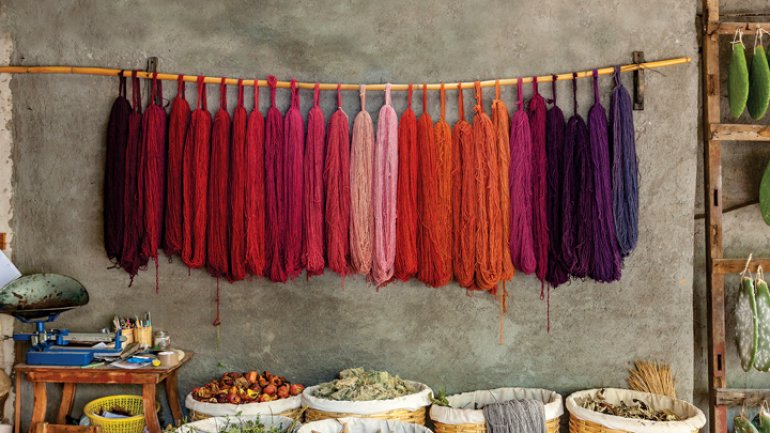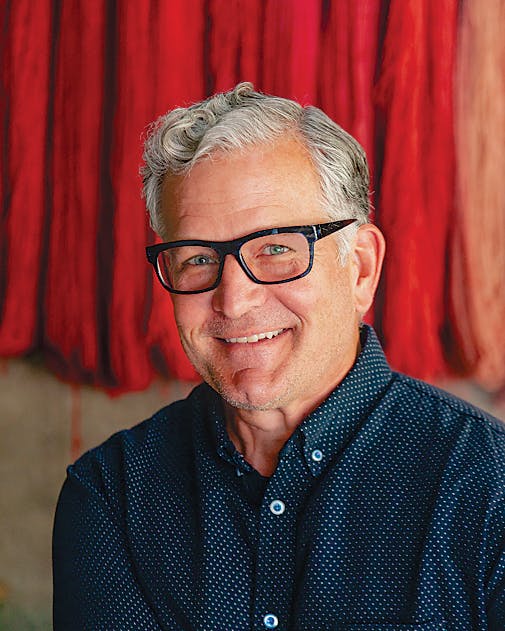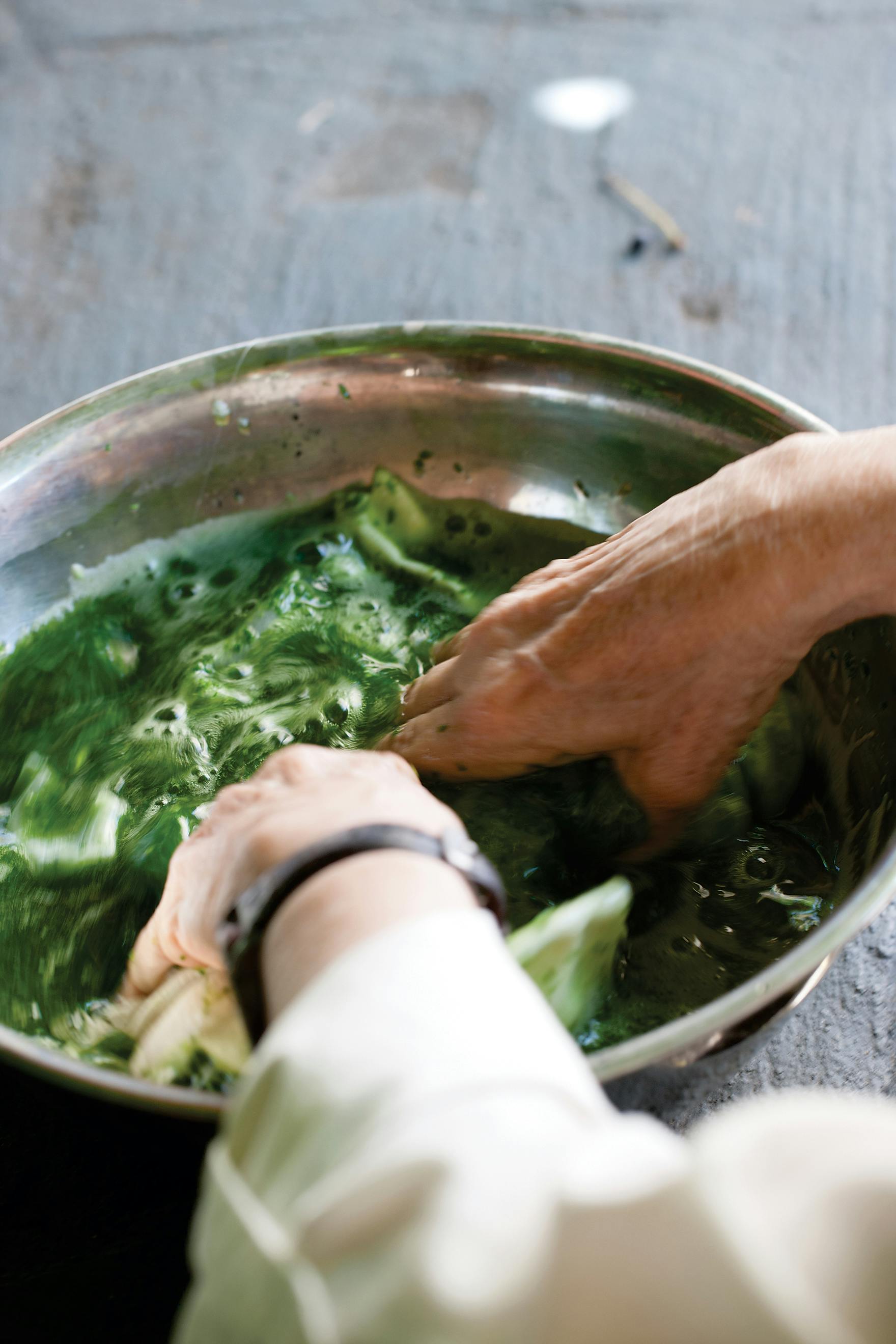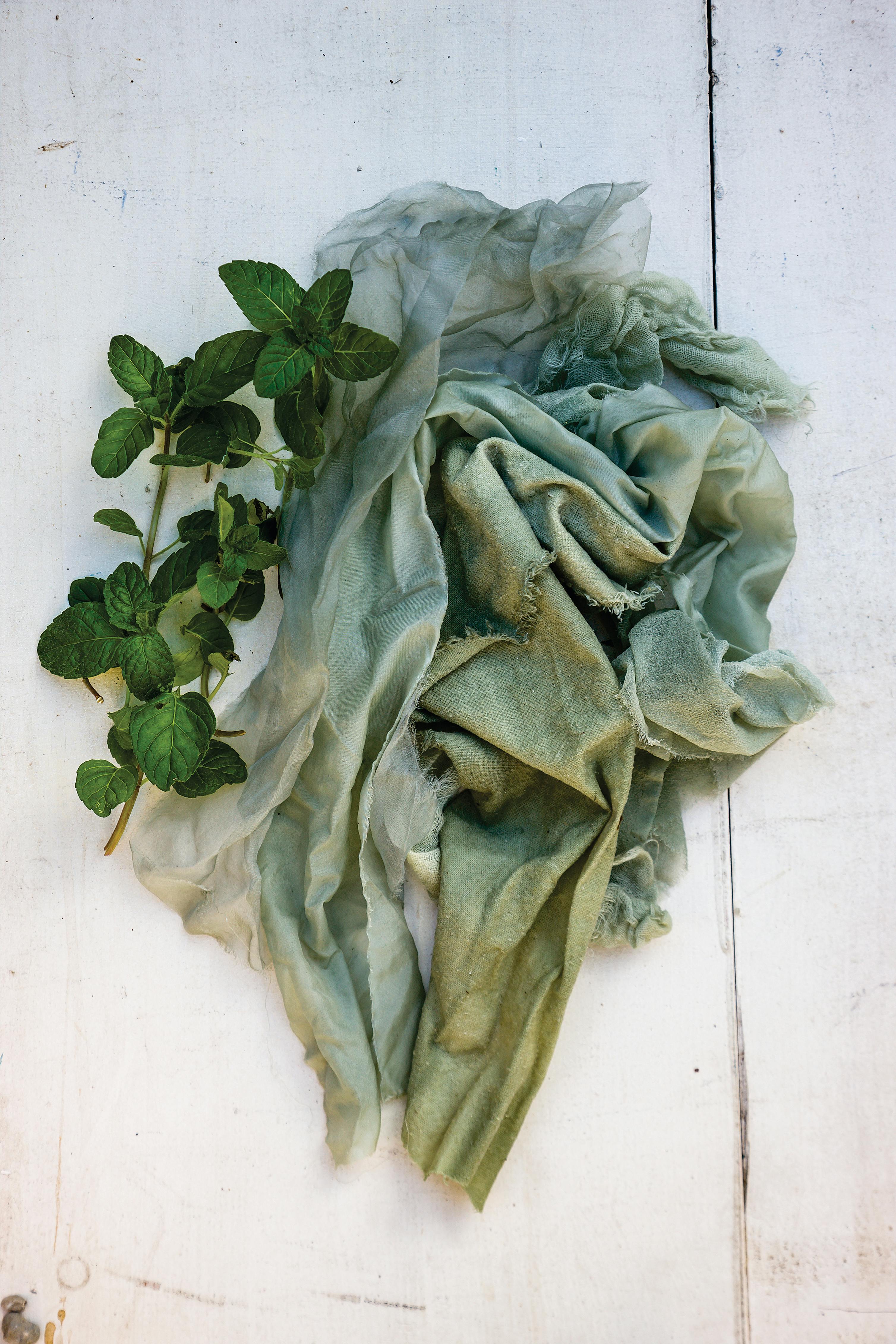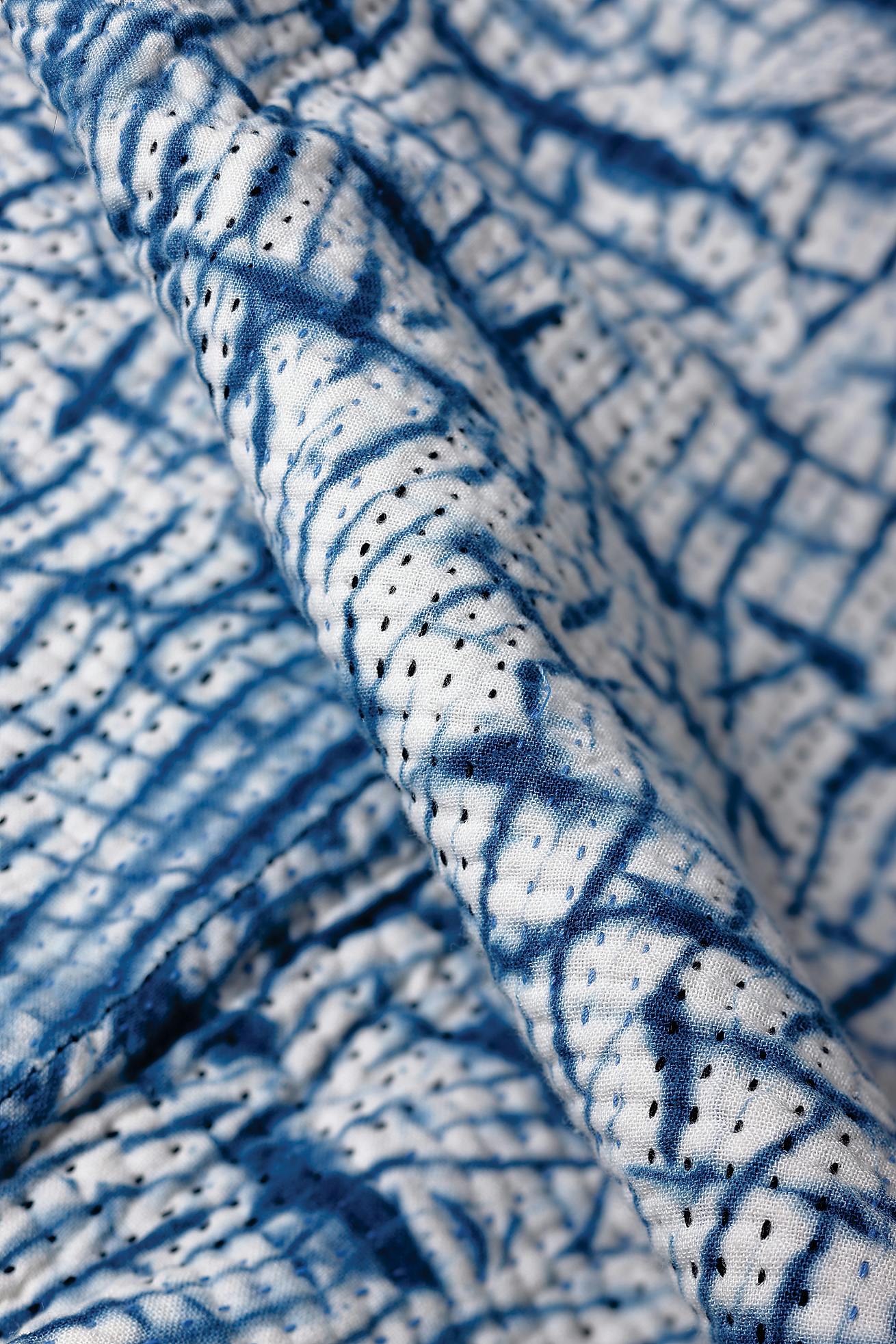Color Vision
Color Vision
↑ A family of reds from Zapotec natural dyer Juana Gutiérrez Contreras.
Photo: Joe Coca
Author, colorist, and artisan activist Keith Recker (@thechromosapien on Instagram) serves as creative director for the International Folk Art Market in Santa Fe, New Mexico, and senior consultant at the Pantone Color Institute. In his latest book, True Colors: World Masters of Natural Dyes and Pigments, he visits natural dye artists around the globe and documents their practices. Here he reflects on his journey and what it can teach us.
What surprised you most about learning from these expert dyers?
Several lifetimes of learning got squeezed into this book. Because there are 26 chapters, I feel like I got a window into 26 different worlds. There’s the super quiet, individual, solitary world of Irene Clark, the Navajo weaver, where we focused on dyes that she makes of lichen. There’s the purple of the Mixtec sea-snail dyers on the coast of Oaxaca, Mexico, which is communal and deeply rooted. There’s the modern encounter with the natural dye substances of Audrey Louise Reynolds, where I focus on turmeric, and María Elena Pombo, where I focus on dye made from avocado pits. And there’s the profound teaching orientation of Sasha Duerr, who talks about natural dyeing as a gateway drug; the gateway through which her students pass is one of eco-awareness.
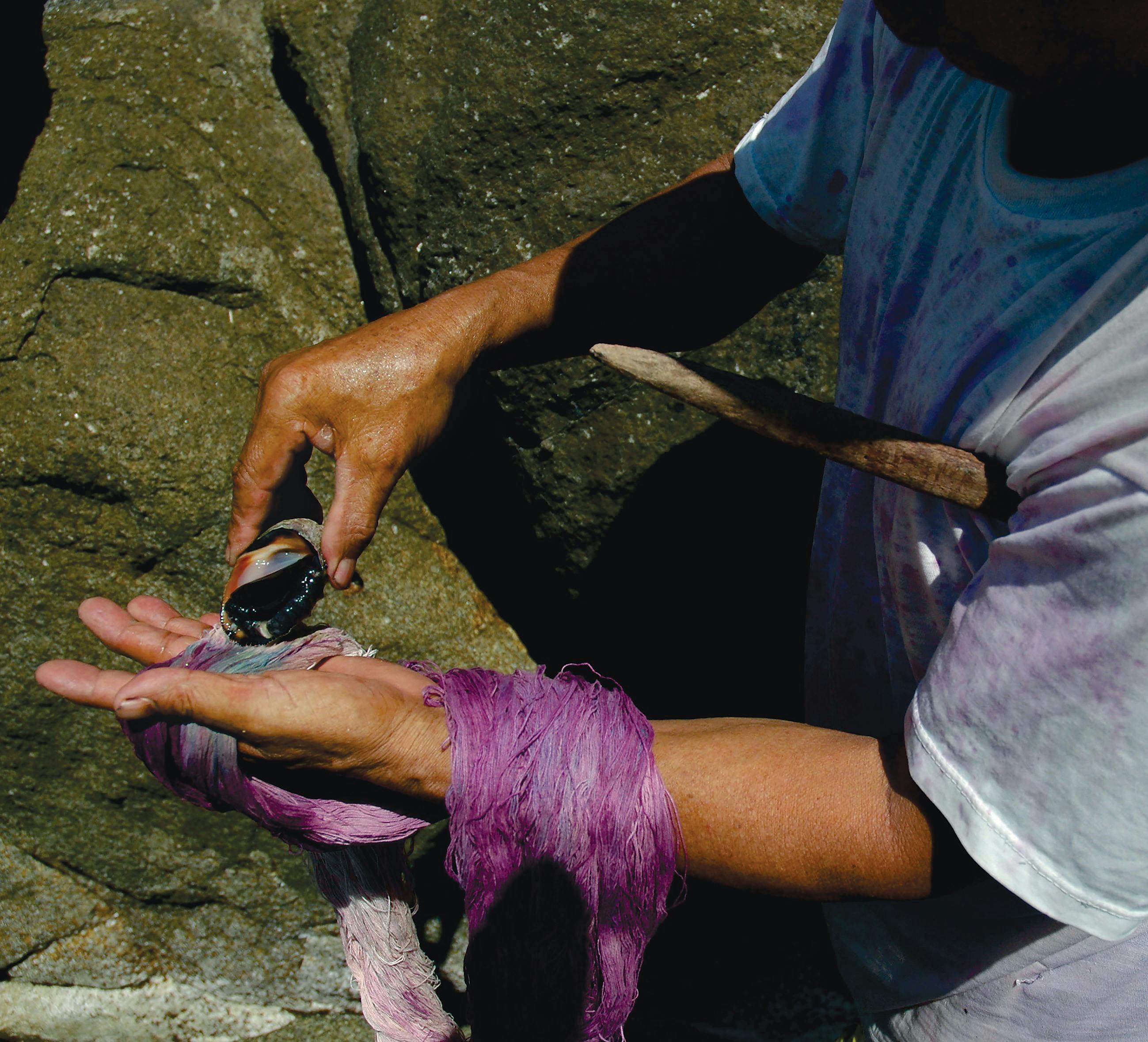
Mixtec dyers from the coast of Oaxaca, Mexico, gently milk sea snails for tixinda, a liquid that ultimately turns yarn purple.
Snail photo: Eric Mindling
Yarn photo: Marcella Echevarria
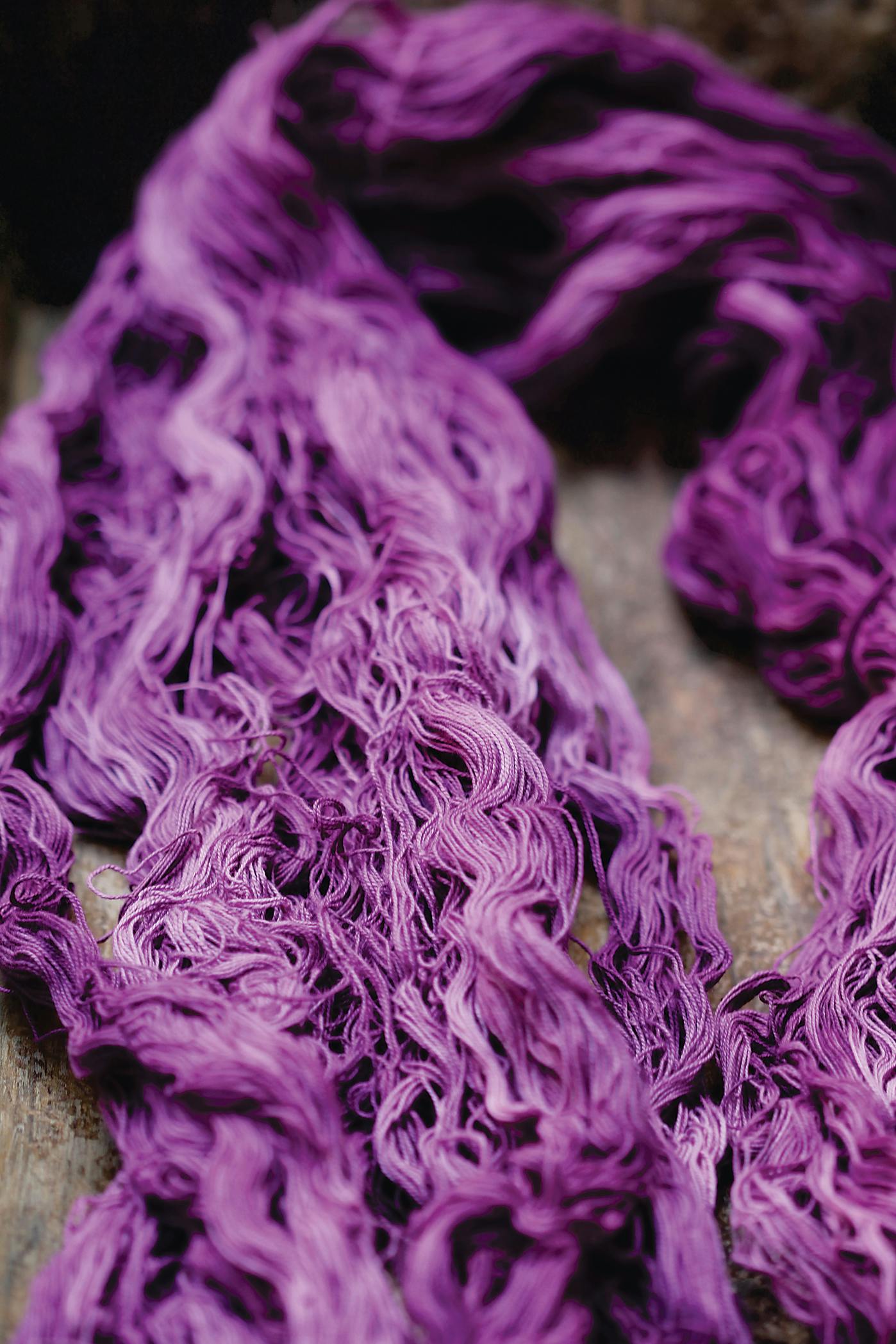
What inspired you to write True Colors?
Over the last 20 years, our relationship to food has fundamentally changed. Our expectations about how things are grown and who grows them and how those people are treated are different. I realized that we do not have that same relationship to what we wear, what we touch, and – except for our shower – what surrounds our skin every waking moment. Why are we not making progress in redefining what we buy, why we buy it, how we use it, what we do with it when we’re done using it?
Natural color has something to offer us as we face the total need to reconfigure our consumption. If we learn how to choose well, we can consume without a sense of repentance – and with a sense of celebration.
I wanted to learn from what we were doing before the 1856 discovery of mauveine, the first synthetic dye – an accidental find of a teenage chemist. He was working with coal tar when he made the first aniline, a substance that was purple. What we were doing with textile dyes before 1856 was 100 percent derived from minerals, plants, and the occasional insect or shellfish. It was all coming from nature. We weren’t always great stewards of nature, but, for the most part, we seemed to understand more or less our responsibility to grow – not to destroy the capacity to grow.
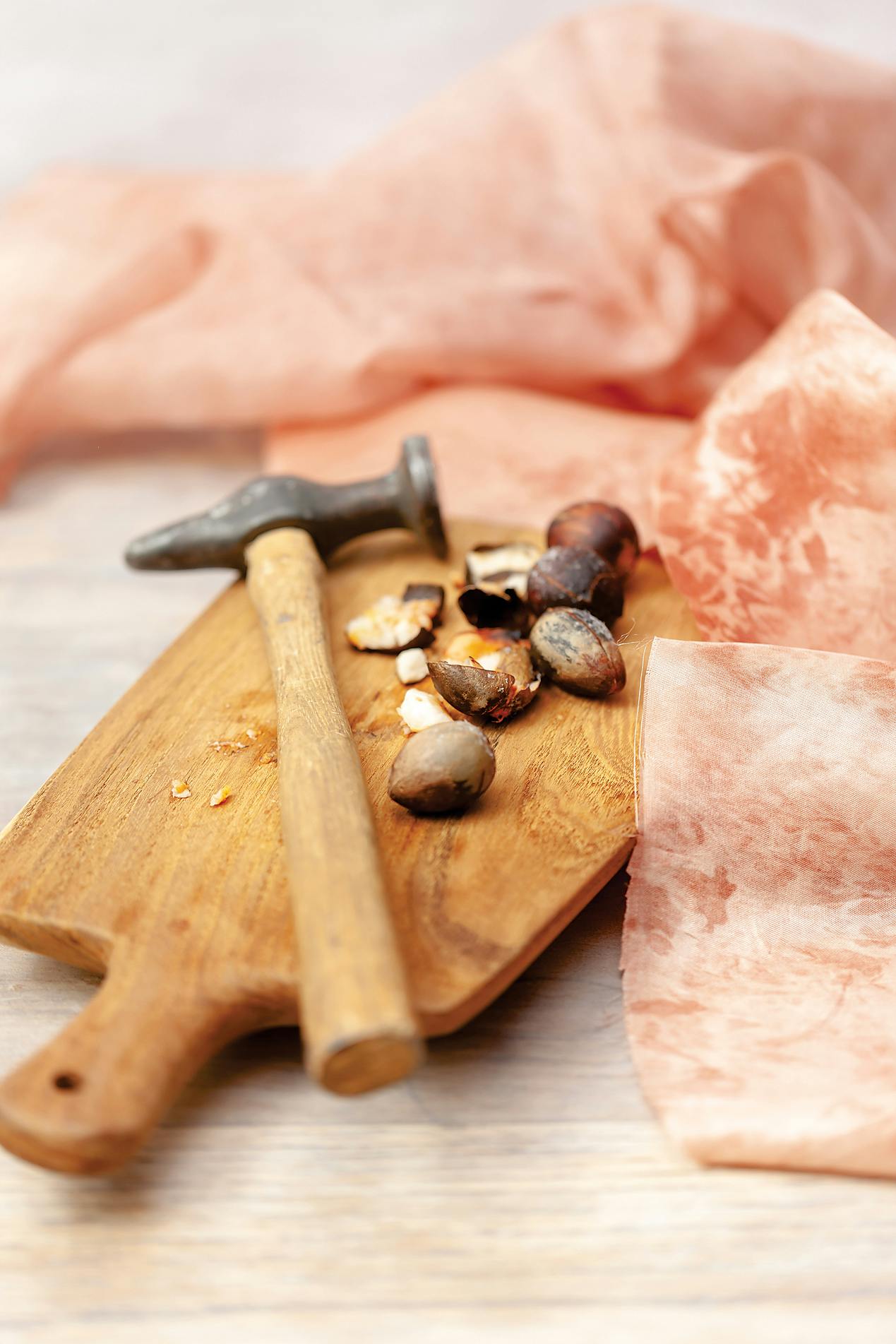
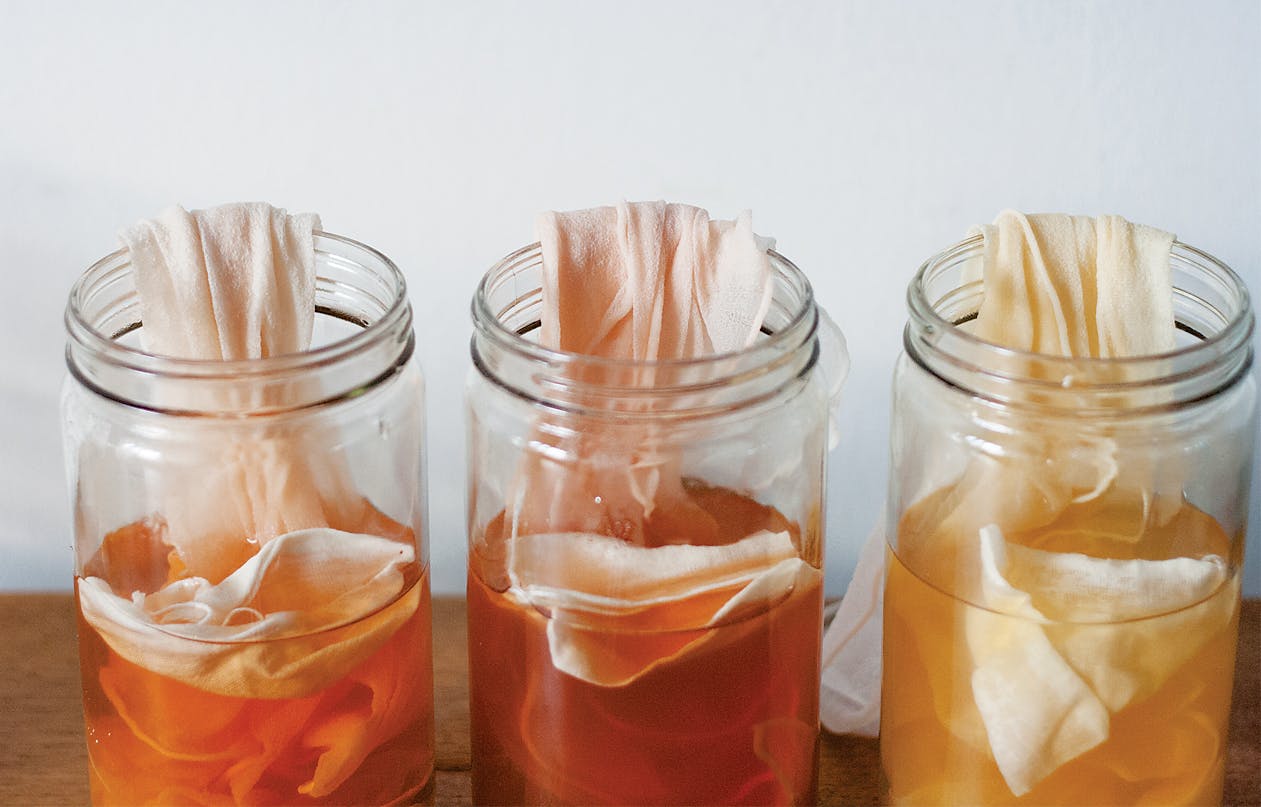
To create a dye bath, avocado pits are first crushed, then soaked in hot water. The colors of the dyes are affected by minerals in the water.
Mason jars photo: Griffin Moore
Hammer photo: Joe Coca
What interests you most about color?
Color gets right to the heart of how we are and who we are. Humans see with three sets of cone cells in our retinas: one tuned to a red wavelength, another to green, and a third one to blue. The red wavelength is something that came to us 30-some million years ago, and the addition of that axis allowed us to see not a million shades of color, but 10 million shades of color.
Why does that adaptation take root? People traditionally say that it was a way to spot ripening fruit. That may be so, but there are plenty of other things that would drive us in that direction. There’s smell, there’s scale. I wonder if the addition of the red axis allowed us to perceive each other more clearly – the flush of anger, the flush of passion, the expressions on our faces, the expression in our bodies; I wonder if red was on some level a social advantage.

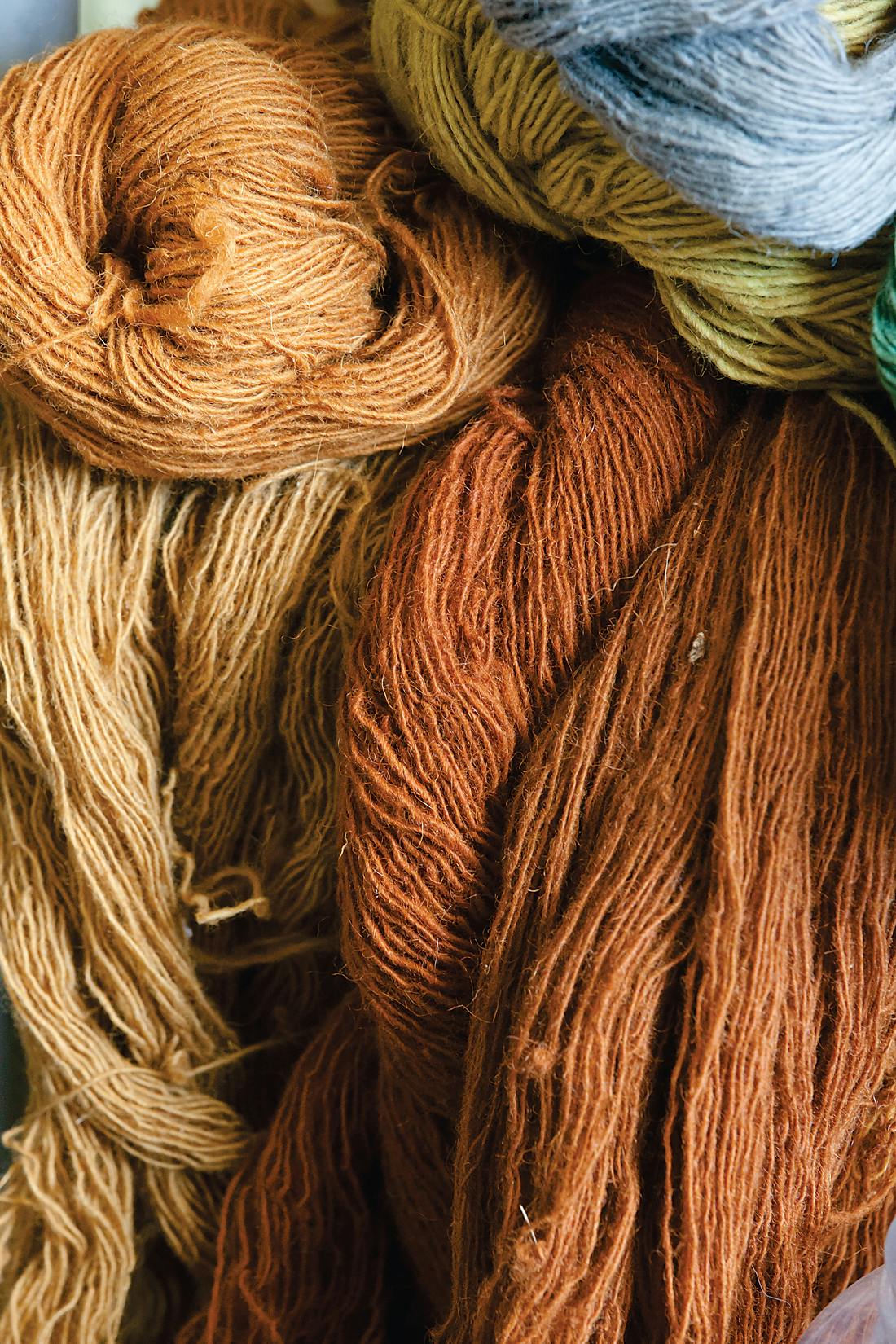
↑ Irene Clark, weaver and keeper of Navajo textile traditions, uses yarn dyed from sources such as lichen, rabbitbrush, blue corn, sagebrush, and walnut for her carpets.
Photo: Joe Coca
In every human language around the world, the words for light and dark are the first two color terms to enter our vocabulary. And where there is a third, red is always the third. Red is the quintessential color for human life. It’s so fascinating to me: The fourth term is almost always green. We turn to ourselves before we turn to look at what surrounds us.
And the cones?
The cones are the color perceivers, and like all machinery, every machine is apt to behave a little bit differently. If we are sitting together looking at the magnolia tree blooming in my backyard, there’s no guarantee that you and I are having the same visual experience. And I love that. It explains so much about our challenges as a species. We might not even be seeing the same thing – let alone interpreting it in the same way, valuing it in the same way, communicating that experience in the same way.
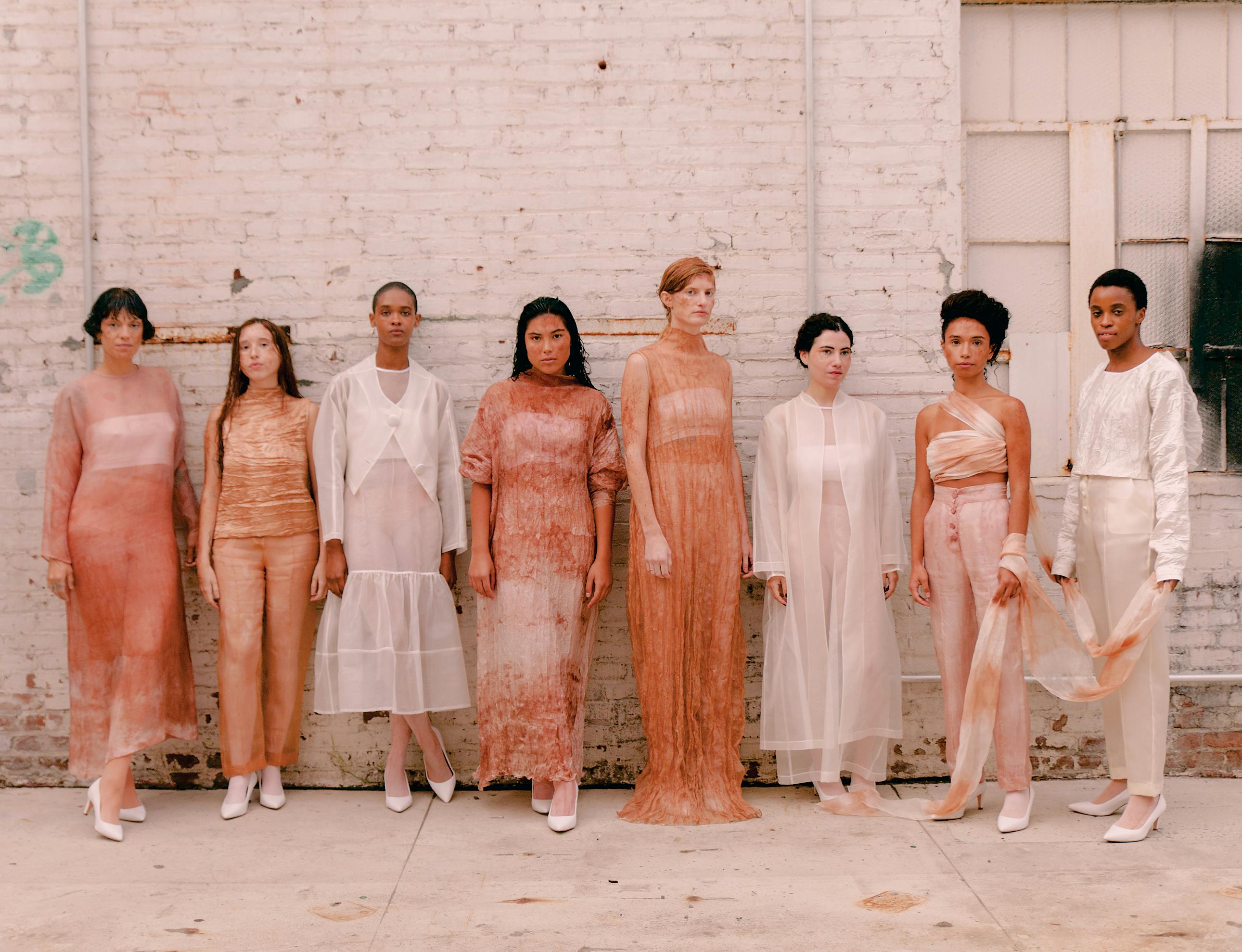
↑ Avocado-dyed garments from the Fragmentario fashion line by designer María Elena Pombo.
Photo: Luis Corzo
Do the natural dye experts see things differently than the people who buy their textiles?
They are certainly attuned to the kind of variation that we might not be attuned to. With most natural dye stuffs, you are dealing with more than one color substance to a pot. The herbaceous plant madder, for example, can give you a range of reds, purples, oranges, ochres, browns, just based on how you process it and the metals and minerals in the dye pot.
In indigo, you have the blue molecules, but you also have indirubins, which are red molecules. Depending upon the amount of heat in the bath, indirubin can come forward to create that more purpley-headed-to-maroon value of some indigo.
So the eye is blending the various wavelengths of light that are being reflected from fibers. It’s a dynamic encounter, as opposed to the encounter with a single chemical absorbed in a predictable and uniform manner by a machine-made fiber.
Color gets right to the heart of how we are and who we are.
↑ In Oakland, California, Sasha Duerr uses mint, rosemary, and pomegranate skins (top), fresh indigo (bottom left), and fresh mint (bottom right) to create a range of colors.
Photos: Joe Coca
What skills do experts of natural dyes and pigments need in order to manifest these colors?
The experts understand the place that their source materials have in the ecosystem around them. They’re sharply attuned to the level of moisture and to the nuances of processing. For woad, a biennial plant whose leaves are best harvested at the peak of sunlight in the summer, the natural dyers know the leaves need to be couched, need to be macerated and pounded into balls and set aside to cure.
So you go from the perception of conditions for handling and processing to the actual technical knowledge of the steps required for fiber preparation that goes into the actual dyeing session.
What do natural dyers have to teach us at this moment in time?
Part of it is the reengagement with the ecosystem around us. Part of it is the refreshment of our sense of time and patience. And I think there’s a value system that we would do well to reconsider – that natural color has something to offer us as we face the total need to reconfigure our consumption. If we learn how to choose well, we can consume without a sense of repentance – and with a sense of celebration.
↑ Shibori designs created with indigo farmed at Living Blue, a social enterprise in Bangladesh.
Photos: Living Blue
What can readers do to support natural dyers?
Part of our obligation as concerned people is to ask all the questions: Where is this thing I’m about to buy made? What is it made of? What are the conditions in which it’s made? Sometimes there won’t be answers, but in this particular moment, the voice of the customer is extraordinarily important. Ask the questions.
Then, research who in your community is a natural dyer and help them organize, for example, over-dye days for pay. Have people show up with a bushel basket of worn clothing and linen and over-dye them in indigo. If you’re super clever, you’ll take all those newly dyed things home, and when you launder them, you’ll put in some old undies, and you’ll end up with a beautiful, vivid, exuberant, sky-blue underwear drawer. For not much money, you can over-dye all the cloth napkins and tea towels you’re trying to use to avoid paper and all of those T-shirts and pajamas that you haven’t been able to launder well, in addition to some old blouses and shirts. You basically end up with a whole new wardrobe.

↑ Han Shan, a Miao dyer near Chengdu, China, lifts bundled fabric out of a vat of dye colored with Strobilanthes cusia, a tropical plant.
Photo: Joe Coca
What’s one color we need to know about now?
The Pantone color of the year for 2020 is called classic blue. It’s definitely one of those indigo shades. I think Pantone was really drawing upon metaphors around blue that established themselves in the Middle Ages, when blue became the color of the Virgin Mary and was terribly, terribly expensive. Of course, the Virgin deserved the most expensive color. Blue assumed her virtues of loyalty, fidelity, care, patience, goodness, and I think that this poetry still resonates within us when we think about blue.
Do you remember looking at pictures of statuettes from ancient Mesopotamia with those massive blue saucer eyes? Well, those eyes are lapis. Those were not portraits of blue-eyed people. Those wide, blue eyes were temple statues of worshippers in the presence of the divine. Their eyes were wide with awe.
Part of our obligation as concerned people is to ask all the questions: Where is this thing I’m about to buy made? What is it made of? What are the conditions in which it’s made?
I link that with the idea now in modern physics that objects that are coming toward you have a blue shift in color, as opposed to objects moving away from you, which have a red shift in color. I find it quite interesting this link between being in the presence of the divine and being in the presence of the things that are coming toward you. Here we are at this moment when we have to fundamentally change. I love that blue is the color of awe and of what’s coming.
Do you have an experience with natural dyeing?
We'd love to hear from you. Send your reactions, reflections, questions, and concerns to [email protected].
Help lift up the voices of our craft community
Become an American Craft Council member and support nonprofit craft publishing. You will not only receive our magazine but also help grow the number of lives craft has touched.


